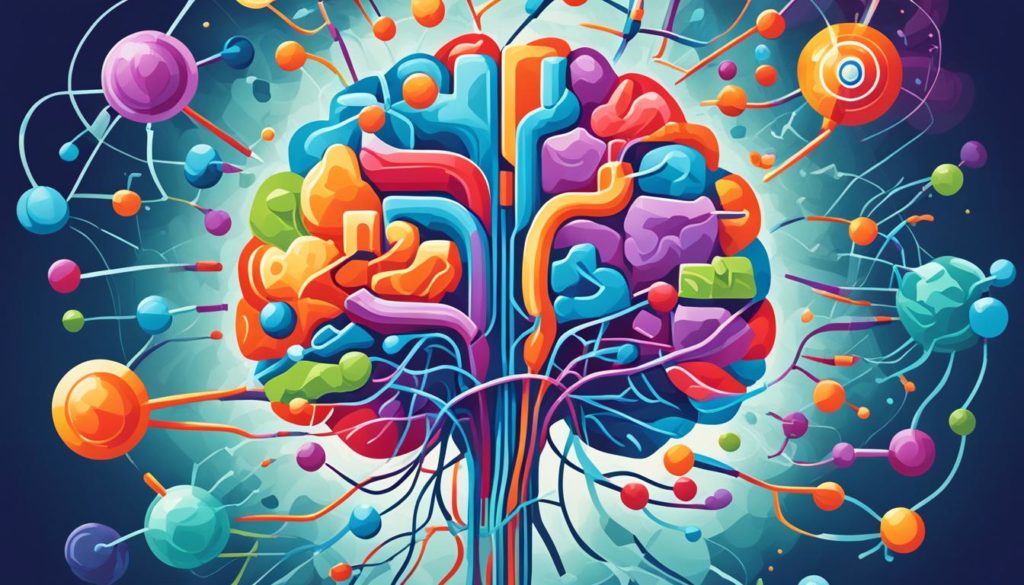Duloxetin, also known as Cymbalta, is a key antidepressant. It helps treat major depression and anxiety. This article will explore how Duloxetin works and its importance in mental health care.
Key Takeaways
- Duloxetin, known under the brand name Cymbalta, treats major depressive disorder and generalized anxiety disorder.
- Recognized for its dual reuptake inhibition, Duloxetin aids in serotonin and norepinephrine balance.
- This medication’s effectiveness extends beyond depression, with several off-label uses.
- Being an antidepressant medication, Cymbalta also comes with a spectrum of common and serious side effects.
- Understanding the correct dosages and potential interactions is crucial for optimizing its benefits.
Introduction to Duloxetin (Cymbalta)
Cymbalta, also known as Duloxetin, is a type of serotonin-norepinephrine reuptake inhibitor (SNRI). It’s made to help with mental health issues by changing the brain’s chemistry. Here’s a quick and detailed look at Cymbalta.
Cymbalta affects neurotransmitters like serotonin and norepinephrine. These are key for mood and pain control. By stopping these chemicals from being taken back, Cymbalta keeps them working longer. This helps with mood and pain.

The Duloxetin introduction talks about its special way of working. It doesn’t just focus on one neurotransmitter like some antidepressants do. This makes it a good choice for treating many mental health issues.
As a serotonin-norepinephrine reuptake inhibitor, Cymbalta stands out among other medicines. Its unique makeup and action can help patients who haven’t found relief with other treatments.
To sum up, Cymbalta’s arrival in the market is a big step forward. Its ability to work in two ways makes it a key tool in treating mental health.
Mechanism of Action: How Does Cymbalta Work
Cymbalta, also known as duloxetine, works in a special way to help with depression. It’s important to know how it works to understand its benefits. The main way it works is by stopping the reabsorption of two important neurotransmitters.

Dual Reuptake Inhibition
Cymbalta stops the reabsorption of serotonin and norepinephrine back into nerve cells. This means more of these neurotransmitters stay in the space between nerve cells. This helps improve mood and reduce depression and anxiety.
Serotonin and Norepinephrine Balance
Keeping serotonin and norepinephrine balanced is key for good mental health. Cymbalta stops these neurotransmitters from being taken back into cells. This keeps their levels high in the brain.
More serotonin helps with mood, anxiety, and happiness. Norepinephrine affects alertness, energy, and focus. Together, these effects show how Cymbalta helps with mood disorders.
Approved Uses of Duloxetin
Duloxetin, also known as Cymbalta, is approved by the FDA for treating major depressive disorder and generalized anxiety disorder. It helps with both depression and anxiety. This makes it key to improving patients’ well-being and daily life.
Depression Treatment
Duloxetin is a strong choice for treating depression. Studies show it helps reduce symptoms like sadness, lack of interest, and thinking problems. People taking it often feel better in their lives and mental health.
Anxiety Management
Duloxetin also helps with anxiety, especially for those with generalized anxiety disorder. It lowers worry, restlessness, and muscle tension. This makes it a great tool for doctors to manage anxiety.
For more info on Duloxetin’s benefits, check out the Health Care Navigator.
Here’s a table to show how effective Duloxetin is for depression and anxiety:
| Condition | Symptom Relief | Quality of Life Improvement |
|---|---|---|
| Depression Treatment | High | Significant |
| Anxiety Management | High | Moderate to Significant |
Off-Label Uses of Duloxetin
Duloxetin, also known as Cymbalta, is well-known for its approved uses. But it also has off-label potential, especially for chronic pain. Studies show it works well for different types of pain, like neuropathic pain, fibromyalgia, and chronic musculoskeletal pain.
The table below shows the main off-label uses of Duloxetin and the research supporting them:
| Off-Label Use | Description | Research Evidence |
|---|---|---|
| Neuropathic Pain | Duloxetin is often prescribed to help with peripheral neuropathic pain, which is common in diabetes patients. | Studies have shown significant pain reduction in patients with diabetic neuropathy. |
| Fibromyalgia | It’s used to manage widespread musculoskeletal pain linked to fibromyalgia. | Clinical trials indicate a notable decrease in pain severity and improvement in overall function. |
| Chronic Musculoskeletal Pain | Used to treat ongoing musculoskeletal pain, including lower back pain and osteoarthritis-related discomfort. | Efficacy backed by multiple studies focusing on musculoskeletal pain relief. |
Doctors have found Duloxetin to be promising for chronic pain management. It offers relief where other treatments may not work as well. It’s important for doctors to consider each patient’s needs and use Duloxetin carefully. This approach helps ensure the best benefits and safety. Off-label uses of Duloxetin expand our understanding of how it can help manage pain more effectively.
Side Effects of Duloxetin
Duloxetin is a powerful tool for managing depression, anxiety, and other health issues. But, it’s key to know about its side effects. Knowing both common and serious side effects helps with monitoring and managing them.
Common Side Effects
Common side effects of Duloxetin are usually mild but can still affect daily life. These include:
- Nausea
- Dry mouth
- Fatigue
- Dizziness
- Constipation
These side effects often get better as your body gets used to the medicine. But, if they don’t go away or get worse, talk to a healthcare provider.
Serious Side Effects
Sometimes, Duloxetin can cause serious side effects that need quick medical help. These include:
- Severe skin reactions
- Seizures
- Liver damage
- Increased blood pressure
- Abnormal bleeding
If you experience serious side effects, get medical advice right away to lessen risks.
The table below lists some common and serious side effects of Duloxetin:
| Common Side Effects | Serious Side Effects |
|---|---|
| Nausea | Severe skin reactions |
| Dry mouth | Seizures |
| Fatigue | Liver damage |
| Dizziness | Increased blood pressure |
| Constipation | Abnormal bleeding |
Knowing about Duloxetin’s side effects, both mild and serious, helps you make better treatment choices. It also supports proactive health care.
Dosage Guidelines for Cymbalta
When taking medication dosage for Cymbalta, always follow your doctor’s advice. Check the Medication Guide for instructions. You might need to adjust the dose based on your health and the condition being treated.
Here are the standard dosage guidelines for Cymbalta for different conditions:
| Condition | Starting Dose | Maintenance Dose | Maximum Dose |
|---|---|---|---|
| Generalized Anxiety Disorder | 30 mg/day | 60 mg/day | 120 mg/day |
| Major Depressive Disorder | 20-30 mg/day | 40-60 mg/day | 120 mg/day |
| Chronic Muscle Pain | 30 mg/day | 60 mg/day | 60 mg/day |
| Diabetic Peripheral Neuropathy | 60 mg/day | 60 mg/day | 60 mg/day |
| Fibromyalgia | 30 mg/day | 60 mg/day | 60 mg/day |
It’s crucial to take the right amount of Cymbalta for it to work well and safely. Always talk to a healthcare provider before changing your dose, especially if you’re thinking about giving it to children.
Make sure to swallow the delayed-release capsule whole. Don’t crush or open it. If you miss a dose, take it as soon as you remember, unless it’s almost time for the next one. Don’t take two doses at once. Keeping the medicine safe and stored right is also key to its effectiveness and safety.
Duloxetin Interactions: What You Need to Know
It’s important to know about Duloxetin interactions to ensure your treatment works well and you stay safe. This drug is often used, but mixing it with other substances can cause interactions.
Drug-Drug Interactions
When you take Duloxetin with other drugs, you need to watch out for interactions. These can make treatments less effective or cause bad side effects. For example, taking Duloxetin with SSRIs, MAOIs, or some painkillers can lead to a serious condition called serotonin syndrome. Always tell your doctor about all the drugs you’re taking to avoid these problems.
Always check with your doctor about possible interactions with other drugs. Here are some interactions you should know about:
| Drug Class | Common Interactions | Risk Level |
|---|---|---|
| SSRIs (e.g., Prozac) | Serotonin syndrome | High |
| MAOIs (e.g., Nardil) | Hypertensive crisis | High |
| NSAIDs (e.g., Ibuprofen) | Increased bleeding risk | Moderate |
| Anticoagulants (e.g., Warfarin) | Enhanced anticoagulant effects | Moderate |
Food Interactions
Food can also affect how Duloxetin works, although not as much as drug interactions. Eating a big meal with Duloxetin might make it start working slower, but it won’t change how much of it your body absorbs. Also, drinking alcohol can make side effects worse, especially if you have liver issues.
To avoid problems with food, follow the diet advice from your doctor. Always talk to them before changing your diet in a way that could affect your medicine.
Benefits and Risks of Duloxetin Therapy
When looking at Duloxetin (Cymbalta) therapy, it’s key to see both the good and the bad. Cymbalta is a mental health medication used for many conditions like depression, anxiety, and chronic pain. A big plus of Duloxetin is how it works on serotonin and norepinephrine. This helps with mood and pain.
Duloxetin helps a lot with depression and anxiety, making life better for patients. It also helps with nerve pain and fibromyalgia. This shows how it can help with both mental and physical health. People feel better in their daily lives, showing how effective this drug is.
But, Duloxetin also has risks to consider. Side effects like nausea, headaches, and feeling sleepy can happen. These are usually not too bad but can affect how well people stick to their treatment. Serious risks like serotonin syndrome and liver problems need close watch, especially for certain people.
For pregnant or breastfeeding women, the risks of Cymbalta might be too high. People with liver issues or taking other drugs that interact with Duloxetin need careful watching. A balanced approach helps patients and doctors make the best treatment choices while avoiding dangers.
Knowing all about Duloxetin helps make better treatment choices. This detailed look helps doctors use this mental health medication safely and effectively.
Conclusion
As we end this detailed look, it’s key to highlight Cymbalta’s wide role in mental health care. It’s used for major depression and anxiety, and even for chronic pain. Knowing all about Duloxetin helps doctors and patients make better choices.
Cymbalta works by balancing serotonin and norepinephrine levels. This article talked about its effects on mental health. It also covered common and serious side effects, showing the need for a doctor’s watchful eye during treatment.
In short, Duloxetin is a big help in mental health care, with many uses. But, it’s important to consider the risks and how it might interact with other medicines. We hope this summary helps you understand Duloxetin better. This way, it can be safely and effectively used in mental health care plans.
FAQ
What is Duloxetin (Cymbalta) used for?
Duloxetin, also known as Cymbalta, treats major depressive disorder and generalized anxiety disorder. It’s also used for chronic pain.
How does Cymbalta work?
Cymbalta works by stopping serotonin and norepinephrine from being taken back into cells. This increases their levels in the brain. This balance helps improve mood and mental health.
What are the approved uses of Duloxetin?
The FDA has approved Duloxetin for major depressive disorder and generalized anxiety disorder. It also treats chronic pain.
Are there off-label uses for Duloxetin?
Yes, Duloxetin is used off-label for neuropathic pain, fibromyalgia, and chronic musculoskeletal pain. Studies show it can help with these conditions.
What are the common side effects of Duloxetin?
Common side effects include nausea, dry mouth, fatigue, dizziness, and constipation. These side effects are usually mild and lessen over time.
What are the serious side effects of Duloxetin?
Serious side effects are rare but can include liver damage, serotonin syndrome, suicidal thoughts, and high blood pressure. Tell your doctor about any unusual symptoms right away.
What are the dosage guidelines for Cymbalta?
Cymbalta dosage depends on the condition being treated. It usually starts at 30 mg daily. The dose may increase based on how you respond. Always follow your doctor’s advice on dosage.
Can Duloxetin interact with other medicines or foods?
Yes, Duloxetin can interact with other drugs like MAO inhibitors and blood thinners. It’s important to tell your doctor about all your medications and supplements.
What should be considered when weighing the benefits and risks of Duloxetin therapy?
Consider the benefits of Duloxetin, like better mood and pain relief, against the risks like side effects and interactions. This helps ensure safe and effective use of the drug.


